
Dr. Andrea Grunier
Older adults have a new ally at the University of Alberta: Andrea Gruneir, an assistant professor in the Department of Family Medicine, who specializes in the understanding of people's needs for health care as they age.
Gruneir is currently looking at older adults who move between sectors of the health-care system-such as between acute care and nursing homes-and how to ease those transitions.
"I'm really trying to make some improvements around the quality of care that older adults receive, not only within each of those settings, but also as they are getting ready to move between them," she says.
A major challenge, according to Gruneir, is that hospital staff may not fully understand what kind of care is available in other settings, such as nursing homes. This may result in patients who are released back into an environment that isn't equipped to provide the required care.
Gruneir joined the Faculty of Medicine & Dentistry in August 2014 and holds a Canadian Institutes of Health Research (CIHR) New Investigator's Salary Award, which will provide $300,000 in funding over five years.
One of Gruneir's latest studies focuses on determining the frequency, causes and trends relating to repeated transfers between nursing homes and emergency care. She hopes to identify opportunities to intervene and reduce the need for these events, with the ultimate goal of making transitions smoother.
Another study that she is working on centres on understanding what happens to older adults when they are discharged and the likelihood of readmission to the hospital. Gruneir notes that many hospitals use 30-day readmission rates to evaluate performance and quality indicators of hospital performance, but these measurements don't factor in living status, cognitive impairment or other challenges unique to treating older patients, resulting in information that may skew information used to compare hospitals.
Understanding readmission rates and causes of hospitalization are particularly relevant issues for patients living with multiple chronic conditions, such as osteoporosis, diabetes and heart disease. Patients may see multiple specialists to manage these ailments but, according to Gruneir, patients often feel as though their specialists are not communicating with each other as closely as they could be. These broken lines of communications become particularly problematic when conditions have contradictory guidelines; for example, where treating one illness will increase risk related to a co-existing ailment.
"[This research] really highlights what some people will call the fragmentation of care within the system and the silos that have traditionally existed between different specialties and different sectors," she says.
"I like the fact that we can study real, everyday problems and identify where they might be opportunities to try to improve things for people now."